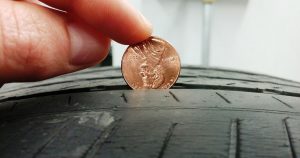 As the barrier between your car’s body and the road, tires are one of the most important parts of your vehicle. Damaged or worn-out tires not only can cost you money but also can risk your safety. Luckily, maintaining your car’s tires is one of the simplest things when caring for your vehicle. Follow these guidelines, and you can be confident that your car’s tires are roadworthy.
As the barrier between your car’s body and the road, tires are one of the most important parts of your vehicle. Damaged or worn-out tires not only can cost you money but also can risk your safety. Luckily, maintaining your car’s tires is one of the simplest things when caring for your vehicle. Follow these guidelines, and you can be confident that your car’s tires are roadworthy.
Check Your Tire Pressure Regularly
The most important thing you can do to care for your tires is to check your tire pressure regularly. Tires lose pressure over time, especially in particularly hot or cold weather. Driving on underinflated tires causes the tread to wear unevenly, reduces your gas mileage, and hinders your car’s handling.
Most new cars have a dashboard indicator that lets you know when your tires need some air. If your car lacks this feature, be sure to keep an air pressure gauge in your car and check your pressure at least once a month.
Keep Your Tires Aligned
Proper tire alignment is critical to keeping even wear on your tires. When tires wear unevenly, they are more susceptible to dangerous blowouts. Poor alignment can also lead to reduced gas mileage and handling ability.
Check for signs of misalignment by inspecting the shoulders of your tires for wear. The tire shoulder is the outer section of a tire’s tread, between the center of the tread and the tire’s sidewall. If the shoulders are worn down, there’s likely an alignment issue. Drifting to one direction while driving on a straight road is another sure sign that you need a tire alignment.
Rotate Your Tires
If you’re getting your tires aligned, it’s a good idea to get a tire rotation as well. Since the front tires direct your car’s steering, their tread wears down faster than the tread on the rear tires. Rotating your tires every 5,000 to 7,000 miles helps the tread to wear more evenly, adding thousands of miles to the life of your tires.
Schedule tire rotations as part of your car’s routine maintenance. Your Toyota dealership will rotate your tires according to your car’s specifications and thoroughly inspect your tires for other safety concerns.
Check Your Tires’ Tread
Eventually, even the best-maintained tires wear out. When tires lose their tread depth, they lose their ability to properly grip the road. Without proper traction, your car can’t stop as quickly and will be more likely to lose control in rain or snow.
You can check tread depth by inserting a penny into the grooves between the tread ribs. Insert the penny with Lincoln’s head facing down into the tread. If you can see the top of Lincoln’s head, it’s time to replace your tires. Be sure to check tread depth in multiple places on each tire to compensate for uneven wear.
Following these four rules of tire care will maximize your car’s performance and extend the life of your tires, letting you know exactly when it’s time to replace them. Always replace tires after six years regardless of tread depth, as the rubber degrades over time.
https://www.flickr.com/photos/cartrapped/23255514263/sizes/m
Image via Flickr by cartrapped



![[Facebook]](https://www.scottclarkstoyota.com/blogs/207/wp-content/plugins/bookmarkify/facebook.png)
![[LinkedIn]](https://www.scottclarkstoyota.com/blogs/207/wp-content/plugins/bookmarkify/linkedin.png)
![[Twitter]](https://www.scottclarkstoyota.com/blogs/207/wp-content/plugins/bookmarkify/twitter.png)
![[Yahoo!]](https://www.scottclarkstoyota.com/blogs/207/wp-content/plugins/bookmarkify/yahoo.png)
![[Email]](https://www.scottclarkstoyota.com/blogs/207/wp-content/plugins/bookmarkify/email.png)


